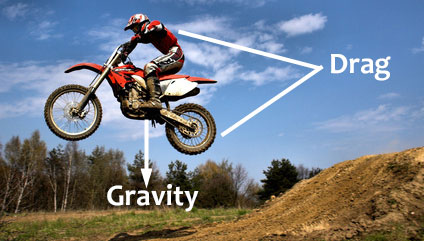Newton's Three Laws
Although the 'ride it like you stole it' maxim works for some experienced riders, beginning dirt bike riders will benefit from taking a few minutes to think before they ride, especially when it comes to something as dangerous as jumping a dirt bike. Most of the physical world we live in is governed by laws of physics discovered by Sir Isaac Newton some 330 years ago, and although Sir Isaac didn't own a dirt bike, Newton's Laws still apply to today's bikes. It can't hurt beginner riders to spend some time thinking about how the laws of physics apply to dirt bikes.
A few things to mention before continuing:
- There's a difference between speed and velocity but they're used interchangeably here. There's also a difference between weight and mass, and it's easier to understand the difference between the two by answering the age-old question of which weighs more; a pound of feathers or a pound of stones?
- This article is paper theory - there won't be any actual dirt bike riding tips on how to jump a dirt bike in this post. That'll be in Part Two.
- This isn't meant to be college-level physics material. It's meant to encourage beginning dirt bike riders to look at jumping a dirt bike in a different, and hopefully, safer way.
- We're going to change the order of the laws around a bit in order to follow the sequence of jumping a dirt bike (ramp, jump, landing).
Newton's First Law (Part I):
Newton's First Law is divided into two parts, and we'll get to Part II shortly. For now, Part I says: An object at rest will remain at rest unless acted upon by an unbalanced force. This is usually referred to as The Law of Inertia. Reality means that while you sit on your dirt bike staring at the ramp wondering if it's such a great idea to launch a perfectly good dirt bike piloted by a totally inexperienced rider up into thin air, the bike will sit there unmoved until you decide to apply an unbalanced force (throttle) to the bike in order to move it up the ramp (or maybe go home and have a beer instead). You finally decide; no guts, no glory, so that brings us to Newton's Second Law . . .

Newton's Second Law:
Newton's Second Law says: Acceleration is produced when a force acts on a mass, and is sometimes stated as F=ma. This means that in order for the dirt bike to accelerate up the ramp, a force must be applied to the bike. Acceleration of the dirt bike is achieved when a force (clutch and throttle engaging the rear wheel) acts on the mass (dirt bike and rider). The greater the mass of the object being accelerated, the greater the amount of force needed to accelerate the object, so a 220 pound rider on a big 450F is going to need more force to get the bike up the ramp than a 150 pound rider on a little KX100. Once the dirt bike is in motion, and (hopefully) airborne, the second half of Newton's First Law comes back into play . . .

Newton's First Law (Part II):
The second half of Newton's First Law says: Every object in motion continues in motion unless acted upon by an unbalanced force. So you've made it up the ramp and the dirt bike is now airborne. According to Newton's First Law, the bike should continue sailing through the air forever, right? Nope. It's the 'unless acted upon by an unbalanced force' caveat that messes with your flight pattern (sometimes with dire consequences). The two main unbalanced forces affecting the airborne dirt bike are drag and gravity. You can look at drag as a kind of friction, and the since a dirt bike with a beginning rider aboard isn't exactly symmetrical, there are plenty of places where the air can get hold and create drag: the inside of the bike's front fender, the handlebars, and the rider's arms, body, helmet, and clothing. But drag isn't the only unbalanced force. The force that brings the bike back down to earth the fastest is gravity. The bike's weight (along with your weight if you managed to hang on when you went airborne) will always be directed towards the Earth's center. The more you and the bike weigh the more attractive you are to the Earth. The landing is inevitable, so that brings us to Newton's Third Law . . .

Newton's Third Law:
Newton's Third Law says: For every action there is an equal and opposite reaction. In simple terms this means: what went up must come down. The problem with a dirt bike coming back down and colliding with the earth is that the bike's contact point is only two (sometimes only one) six-inch tires. Although dirt bikes have great suspensions, the overall mass of dirt bike and rider is still a bit unwieldy and top heavy which can cause the bike to react in unexpected ways upon impact.
Compare the dirt bike to a bouncing ball. When you release the ball from your hand, gravity starts the ball falling to the earth. Since the ball is so much lighter than the earth, once it lands it has no choice other than to rebound, converting the impact with the earth into energy to propel it back upward. This will continue until the ball's energy is dissipated or until an external force is applied; such as grabbing the ball with your hand to stop the momentum, or hitting the ball with a bat to convert the momentum.
When it comes to jumping a dirt bike, although a dirt bike is heavier than a bouncing ball, it's still not as heavy as the Earth and will succumb to the bouncing ball's fate of rebound effect. The images below show the similarity between a bouncing ball and a dirt bike coming off a jump. The dirt bike wants to rebound on impact and has essentially the same options as the bouncing ball - stop the momentum (you crashing the bike), or converting the momentum. To convert the upward momentum of the bike an external force needs to be applied, and this external force is the throttle.

That's Newton's Three Laws in a nutshell and brings us to the conclusion of Part One of jumping a dirt bike. Part Two offers a few tips for jumping a dirt bike and will try to tie theory in with reality.
Newton's Law Videos:
Here are a few videos from the Science of NFL Football series that show more real-life examples of Newton's Laws at work:
